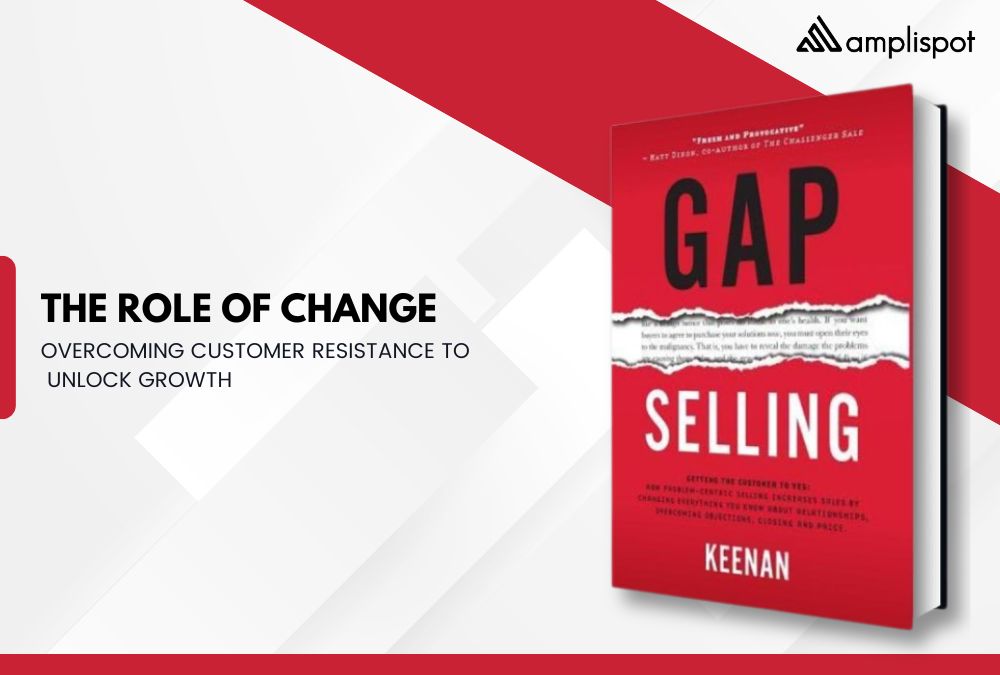Chapter 9
“People resist change more than they resist you.” — Keenan, Gap Selling
In today’s rapidly evolving business landscape, the ability to drive change is essential for companies looking to maintain a competitive edge. Yet, one of the most common challenges faced by sales professionals is overcoming customer resistance. In Chapter 9 of Gap Selling, Keenan highlights that customers often cling to the status quo despite its shortcomings. Understanding and addressing this resistance is crucial for persuading customers to transition from their Current State to a more efficient and profitable Desired Future State.
Understanding the Roots of Resistance
Before diving into strategies to overcome resistance, it’s important to understand why customers resist change in the first place. Three primary psychological factors contribute to this behavior:
1. Fear of the Unknown
Change brings uncertainty. Customers may be reluctant to adopt a new solution because they worry about potential disruptions or unforeseen challenges. This fear is deeply rooted in the natural human aversion to risk.
- Unpredictability: New systems or processes might introduce unknown variables.
- Risk of failure: There’s always a concern that a new solution won’t deliver as promised.
2. Comfort with the Status Quo
Even if a current system is inefficient, familiarity offers a sense of security. The status quo is predictable—even if it’s suboptimal—and venturing into something new disrupts that comfort.
- Predictability: A known system may be flawed, but it is predictable.
- Low learning curve: Staying with what they know avoids the learning and adaptation required for change.
3. Perceived Effort and Cost
Implementing change is often associated with significant time, effort, and financial investment. Customers might overestimate these costs, seeing them as insurmountable barriers.
- Overestimated Implementation: The perceived complexity of transitioning can deter decision-makers.
- Short-term vs. Long-term: Immediate costs can overshadow potential long-term benefits.
The High Cost of Doing Nothing
While change can be daunting, maintaining the current state often comes with hidden costs that can severely impact a business over time.
Quantifying Opportunity Costs
Every month a customer delays change, they might be losing tangible value. For example, if an outdated system is causing delays that cost a company $20,000 annually, that loss compounds over time. Breaking it down:
- Monthly Losses: If each month’s delay costs $1,500, then in just one year, the business loses $18,000.
- Long-term Impact: Over several years, these costs escalate, leading to significant lost revenue and efficiency.
Risks of Inaction
When customers focus solely on the immediate hassle of change, they often miss the broader picture. Here are some risks of inaction:
- Competitive Disadvantage: Competitors adopting newer, more efficient technologies may leave laggards behind.
- Inefficiency: Persistent inefficiencies can lead to wasted resources, lower productivity, and missed revenue opportunities.
- Stagnation: Without change, companies may struggle to innovate or scale, leading to long-term stagnation.
A Step-by-Step Guide to Overcoming Resistance
Sales professionals can turn resistance into opportunity by carefully guiding customers through the change process. Here’s a more in-depth look at a five-step strategy to overcome customer hesitance:
Step 1: Understand Their Concerns
The first step is to actively listen to the customer’s reservations. This means asking open-ended questions to uncover their deepest concerns.
- Conduct a Thorough Needs Analysis: Ask about past experiences with change, current pain points, and expectations for a new solution.
- Empathize: Show genuine understanding. For example, “I understand that switching systems can seem risky, but let’s break down exactly what those risks are and how we can manage them.”
Step 2: Revisit the Gap Between Current and Desired States
Revisiting the gap helps remind the customer of the issues with their current process and the tangible benefits of change.
- Identify Key Pain Points: Map out the specific challenges that the current state poses. This might include delays, high operational costs, or inefficiencies.
- Envision the Future: Paint a clear picture of the Desired Future State. Highlight improvements such as streamlined operations, increased revenue, and enhanced competitive positioning.
Step 3: Emphasize the Cost of Inaction
To spur action, customers must understand that the status quo isn’t sustainable. Use data and tangible metrics to drive this point home.
- Present Data-Driven Insights: For instance, “Every month your current system costs you $1,500 in lost productivity. Over the next year, that’s $18,000 you’re missing out on.”
- Showcase Long-Term Impact: Use case studies or scenarios to illustrate how continued inaction could lead to significant financial and operational losses.
Step 4: Make Change Manageable
Break the process of change into smaller, achievable steps. This makes the overall transition less intimidating and more actionable.
- Develop a Roadmap: Outline clear, step-by-step stages of the implementation process.
- Highlight Support Structures: Emphasize the training, support, and resources available to make the transition seamless.
- Address Specific Fears: For example, if integration is a concern, explain how the new system is designed to work with existing tools, minimizing disruption.
Step 5: Create a Sense of Urgency
Finally, instill a sense of urgency to prompt immediate action. This can be achieved by emphasizing the risks of delay and the benefits of prompt implementation.
- Highlight Time-Sensitive Benefits: For instance, “By acting now, you’ll avoid another month of lost revenue.”
- Use Limited-Time Offers or Incentives: This can further encourage the customer to make a timely decision.
Real-World Example: A Case Study
Consider a sales scenario where a customer expresses hesitation about switching systems:
Customer Objection: “Switching to your platform sounds promising, but our team is comfortable with our current system.”
Salesperson’s Strategy:
- Understanding Concerns:
The salesperson asks, “Can you share what specific features of your current system your team values? What are your main concerns about transitioning?” - Revisiting the Gap:
“I understand the comfort of familiarity, but let’s examine the issues. Your current system is causing delays that, based on our analysis, cost your team an estimated $20,000 annually.” - Emphasizing the Cost of Inaction:
“Every month of delay translates into roughly $1,500 in lost revenue. Over time, this inefficiency adds up, affecting your bottom line significantly.” - Making Change Manageable:
“Our onboarding process is designed to integrate seamlessly with your existing tools. We’ll break the transition down into manageable phases with comprehensive training to ensure a smooth changeover.” - Creating Urgency:
“Considering the ongoing costs, acting now means you can start saving immediately and avoid further losses. Let’s set a timeline that works for you so we can begin making these improvements as soon as possible.”
Outcome:
By methodically addressing the customer’s concerns, quantifying the cost of inaction, and making the process feel manageable, the customer recognized the urgency and the potential benefits of change, ultimately committing to the new solution.
Additional Insights and Best Practices
Behavioral Economics and Change
Behavioral economics explains much about why individuals resist change. Concepts such as loss aversion (the tendency to prefer avoiding losses rather than acquiring equivalent gains) play a significant role. By framing the change in terms of preventing a loss rather than merely pursuing a gain, you can align your messaging with your customer’s natural instincts.
The Role of Leadership in Driving Change
Change isn’t just a sales challenge; it’s a leadership challenge as well. Leaders must champion change, set a clear vision for the future, and demonstrate commitment to the process.
Building Trust Through Transparency
Trust is fundamental to overcoming resistance. When customers feel that you’re transparent about potential challenges and how they will be managed, they’re more likely to embrace the change.
- Case Study Example:
A software company increased customer adoption rates by hosting webinars that detailed the onboarding process, shared success stories, and provided live Q&A sessions to address concerns in real time.
Utilizing Data and Analytics
Incorporating data into your conversation not only quantifies the benefits but also builds credibility. Use analytics to:
- Show Performance Improvements: Compare metrics before and after implementing the solution.
- Predict Future Outcomes: Use predictive analytics to forecast the potential revenue gains or cost savings.
Relevant Resources and Further Reading
In the journey of driving business growth, the ability to overcome resistance to change is a crucial skill for any sales professional. By understanding the psychological underpinnings of resistance, quantifying the real costs of inaction, and breaking down the process of change into manageable steps, you can guide customers toward decisions that unlock greater efficiency, higher revenue, and sustainable competitive advantage.
Embrace the challenge of change not as a hurdle but as an opportunity to lead your customers into a future of improved performance. Remember, the key is empathy, clarity, and urgency—demonstrating that the risks of staying the same far outweigh the temporary discomfort of transition.
By integrating these strategies into your sales process, you are not only selling a solution—you are building a bridge from the present struggles to a future of growth and innovation. Happy selling!



